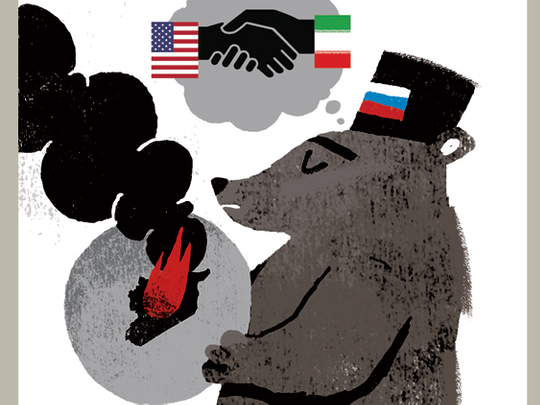
So far, and unless something unexpectedly springs up to derail John Kerry’s carefully crafted step-by-step movements in the region, improvement of Iran’s relations with the US and its allies is now practically edging towards more stability rather than the opposite.
An interesting result one would seriously hope for, will eventually lead to the gradual end of the killing machine, significantly aided by Hezbollah’s direct participation in Syria, and hugely shrinking the survival kit of Bashar Al Assad’s regime. And if this is to happen, it would, by default, weaken Russia’s hand in Damascus. Now, with Egypt opening up to Russia the scene becomes more interesting.
Some might consider this as “easier said than done”. It is quite possible, but equally it is not, particularly when we notice the dialogue between the P5+1 (permanent Security Council’s members plus Germany) with Iran not only still on track, but moving positively forward indeed.
The recent critical statement by Barack Obama of Russia’s delaying and stalling tactics in the Middle East, reflects a “feel-good factor” in the overall US foreign policy in the region. The US president accused the Russians of breaking their promises in cooperating with the US to help sort out the nearly three-year-old bloody conflict in Syria.
Obama’s expected visit to the region next month should hopefully provide us with the desperately needed vision and policy for a settlement in Syria and for restoring stability in the region. Such a settlement must aim at achieving two highly essential targets: First, to put an immediate end to the unprecedented insane killing and destruction of the country. And second, lay down the basic structure for a transitional process to form a well-balanced government that should be shouldered by comprehensive and solid regional support. The forthcoming discussion between Obama and the Saudi Arabia’s King Abdullah Bin Abdul Aziz, will be essentially a cornerstone for such a policy to succeed.
Similarly, we understand that talks over this policy have already started between US and Iranian officials. In fact, addressing an international conference in Munich a few weeks ago, the Iranian Foreign Minister Mohammad Javad Zarif rightly elaborated on the issue. He said, Iran and Saudi Arabia need not fear each other because they “share a common interest in a secure environment.” He went further : “Neither one of us will benefit from sectarian divisions, neither one of us will benefit from extremism.” But his country needs to speedily translate his words into action.
It is peculiar to hear Zarif talking to the regional neighbours when his country is arming Hezbollah fighters and Iranian-trained Iraqi Shiite militias and sending them to Syria to aid a hopeless regime.
However, putting the rhetoric aside, this is the right approach for any potential regional role in the future: co-operation. It is likely that Obama’s visit and his talks with the Saudi king may open the door wide to such a process. If this were to happen, the first step is to lay down an unambiguous policy aiming to get all foreign troops out of Syria, including the extremist Islamists, Hezbollah and Iraqi militias.
Left on its own, without such a regional security accord, the already devastated Syria will eventually tear itself apart. The seeds are already there and they threaten the region and beyond.
Recently released figures by the US National Intelligence Agency are alarming to say the least. In his annual report delivered last Tuesday to the US Senate Armed Services Committee, the agency Director James Clapper, listed events in Syria among “current and future worldwide threats to the US national security”.
The report says there is “actual human disaster of catastrophic dimension,” with 2.5 million refugees (in Turkey, Lebanon, Iraq, Jordan and Egypt), at least 6.5 million displaced persons and “more than 134,000 dead”. It also highlighted the atrocities committed by the government against civilians. “There is widespread torture and killing by President Al Assad’s government on an unprecedented scale unlike anywhere in the world,” the report confirmed.
With a regime not sufficiently strong to control the country and an opposition which is desperately in need of arms and equipment, NIA’s overall assessment is that Syria has become a source of “instability in the region and represents danger to the US and EU countries”.
The agency estimates that there are between 75,000 and 115,000 forces belonging to at least “150 different political groups inside the country”. NIA believes there is between 20,000 and 26,000 extreme fighters, among them 7,500 foreigners from about 50 countries, including few hundreds well-trained Al Qaida members who took part in wars in Afghanistan and Pakistan. “The latter are eager to attack US and European targets”, Clapper said.
Now, in addition to US-Iran growing understanding, there are signs that point to a possible and significant shift of emphasis for Russia’s diplomacy in the region, emanating from the recent visit of Egypt’s military chief, General Abdul Fattah Al Sissi, to Moscow and his talks with President Vladimir Putin.
The visit is full of symbolism but with Gulf states’ aid of $2 billion (Dh7.34 billion) in his kitty to possibly spend on Russian arms, the most likely future president of Egypt might convince Moscow to reverse its policy away from Syria and its chief who increasingly looks like a departing president.
Mustapha Karkouti is a former president of the Foreign Press Association, London.









